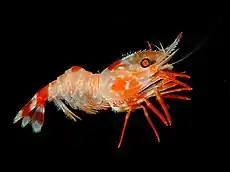Heterocarpus
Heterocarpus is a genus of deep-sea shrimp, mainly of tropical areas all over the world.
| Heterocarpus | |
|---|---|
 | |
| Heterocarpus ensifer | |
| Scientific classification | |
| Kingdom: | |
| Phylum: | |
| Subphylum: | |
| Class: | |
| Order: | |
| Infraorder: | |
| Family: | |
| Genus: | Heterocarpus A. Milne-Edwards, 1881 |
| Type species | |
| Heterocarpus ensifer A. Milne-Edwards, 1881 | |
Description
Heterocarpus is characterised by the highly unequal second pair of pereiopods: one side is long and thin and the other is short but stronger, besides the carapace with one or more longitudinal carinae.[1][2]
Species
So far, 30 species have been described for this genus, Heterocarpus ensifer being the type species. The described species of this genus are:
- Heterocarpus abulbus Yang, Chan & Chu, 2010
- Heterocarpus affins Faxon, 1893
- Heterocarpus alexandri A. Milne-Edwards, 1883
- Heterocarpus amacula Crosnier, 1988
- Heterocarpus calmani Crosnier, 1988
- Heterocarpus chani Li, 2006
- Heterocarpus corona Yang, Chan & Chu, 2010
- Heterocarpus cutressi Monterossa, 1988
- Heterocarpus dorsalis Bate, 1888
- Heterocarpus ensifer A. Milne-Edwards, 1881
- Heterocarpus inopinatus Tavares, 1999
- Heterocarpus intermedius Crosnier, 1999
- Heterocarpus gibbosus Bate, 1888
- Heterocarpus grimaldii A. Milne-Edwards & Bouvier, 1900
- Heterocarpus hayashii Crosnier, 1988
- Heterocarpus hostilis Faxon, 1893
- Heterocarpus laevigatus Bate, 1888
- Heterocarpus lepidus De Man, 1917
- Heterocarpus longirostris McGilchrist, 1905
- Heterocarpus neisi Burukovsky, 1986
- Heterocarpus oryx A. Milne-Edwards, 1881
- Heterocarpus parvispina Crosnier, 1988
- Heterocarpus reedi Bahamondi, 1955
- Heterocarpus sibogae De Man, 1917
- Heterocarpus signatus Rathbun, 1906
- Heterocarpus tenuidentatus Crosnier, 2006
- Heterocarpus tricarinatus Alcock & Anderson, 1894
- Heterocarpus unicarinatus Borradeile, 1915
- Heterocarpus woodmasoni Alcock, 1901
- Heterocarpus vicarius Faxon, 1893
Ecology
.jpg.webp)
Many Heterocarpus shrimp are known for using bioluminescence as a defense, spitting it on predators.[3] Studies about their feeding habits,[4] and the fact that they may be found in the stomach contents of some pelagic sharks[5] and other fishes[6] is interpreted as they have benthic habits, but they do migrations to the water column at night. Some species of this genus have high fishery potential, such as H. reedi [7] and H. laevigatus.[8]
References
- Fenner A. Chace, Jr. (1985). "The Caridean Shrimps (Crustacea, Decapoda) of the Albatross Philippine Expedition, 1907–1910, Part 3: Families Thalassocarididae and Pandalidae". Smithsonian Contributions to Zoology. 411 (411): 1–143. doi:10.5479/si.00810282.411.
- Alain Crosnier (1988). "Sur les Heterocarpus (Crustacea, Decapoda, Pandalidae) du sud-ouest de l'océan Indien. Remarques sur d'autres espèces ouest-pacifiques du genre et description de quatre taxa nouveaux". Bulletin du Muséum national d'Histoire naturelle, Paris. 4ème série. 10 (A 1): 57–103. doi:10.5962/p.287497. S2CID 133303744.
- B. K. K. Chan; I. C. Lin; T. W. Shih; T. Y. Chan (2008). "Bioluminescent emissions of the deep-water pandalid shrimp, Heterocarpus sibogae De Man, 1917 (Decapoda, Caridea, Pandalidae) under laboratory conditions". Crustaceana. 81 (3): 341–350. doi:10.1163/156854008783564064.
- S. F. Rainer (1992). "Diet of prawns from the continental slope of north-western Australia". Bulletin of Marine Science. 50 (2): 258–274.
- Teodoro Vaske Júnior; Carolus Maria Vooren; Rosangela Paula Lessa (2009). "Feeding strategy of the night shark (Carcharhinus signatus) and the scalloped hammershark (Sphyruna lewini) near seamounts off northeastern Brazil". Brazilian Journal of Oceanography. 57 (2): 97–104. doi:10.1590/S1679-87592009000200002.
- M. G. King (1984). "The species and depth distribution of deepwater caridean shrimps (Decapoda, Caridea) near some Southwest Pacific islands". Crustaceana. 47 (2): 174–191. doi:10.1163/156854084X00405. JSTOR 20103973. S2CID 84728160.
- P. E. Pérez (2007). "An economic analysis of the Heterocarpus reedi and Cervimunida johni fisheries off northern-central Chile, from 1997 to 2000". Investigaciones Marinas. 35 (2): 45–52. doi:10.4067/S0717-71782007000200005.
- Stephen Ralston (1986). "An intensive fishing experiment for the caridean shrimp, Heterocarpus laevigatus, at Alamagan Island in the Mariana archipelago" (PDF). Fishery Bulletin. 84 (4): 927–934.